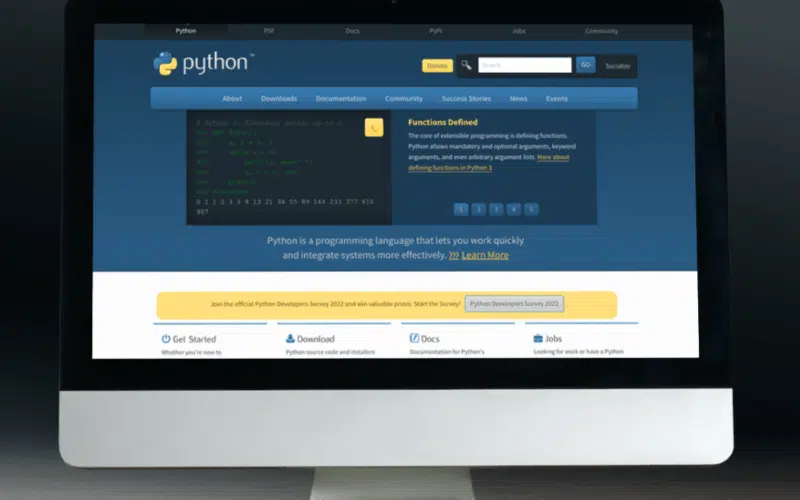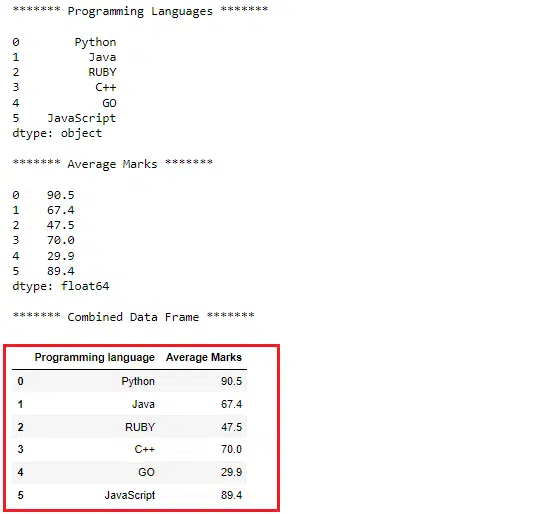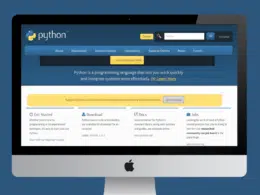Are you looking for different methods in Python to combine two series into a DataFrame in Pandas with Python?
Pandas is a powerful Python library for working with data. It provides a wide range of tools and methods for transforming and analyzing data in Python. One common task in data analysis is combining multiple data sources into a single data frame.
This article will provide a detailed overview of Python’s different methods to combine two series into a DataFrame. The Python Pandas library has different approaches and built-in methods that help merge two individual series into one DataFrame.
The following are the four Pandas methods used to combine two or more series into a single DataFrame:
- The pandas.concat() function
- With the series.append() function
- In the Pandas.merge() function
- With the Dataframe.join() function
Let’s look at each along with examples. But, before going into the details, learning how to create a series using Pandas in Python is essential:
Table of Contents
How to Create a Series Using Pandas in Pandas Python?
A series is a one-dimensional labeled array (row or column) capable of holding data of any data type like objects, int, string, etc. And the data in a series is stored in sequential order. Let’s have a practical example of creating a series in Python:
Code
# import pandas library
import pandas as pd
# creating a series
series = pd.Series(['Python', 'Java',
'RUBY', 'C++',
'GO', 'JavaScript'], name = "Programming languages")
print(f"******* Series *******\n\n{series}")
Output
******* Series ******* 0 Python 1 Java 2 RUBY 3 C++ 4 GO 5 JavaScript Name: Programming languages, dtype: object
This function pd.Series([ list ]) is responsible for creating a series in Python, which expects a list to convert into a series. The above code example has demonstrated the conversion of an index into a series, which you can further use to merge with other series to create a DataFrame.
Now you have understood how to create a series in Python using pandas, it’s time to explore more and learn how to combine two series into a DataFrame.
How to Combine Two Series Into a DataFrame in Pandas Python?
As discussed previously, we have different functions to combine two or more series into a DataFrame in Python. Each can help us in creating a DataFrame from these series; let’s have a look at each one by one:
Combine Series Using the pandas.concat() Function
The concat() is used to concatenate the two defined series into a DataFrame. It is responsible for performing all the concatenation operations. Let’s have a look at the implementation part:
Code
# create a series from a list.
def createSeries(series_list):
# create a series
series_list = pd.Series(series_list)
return series_list
# series no 1 --> series of programming languages
programming_lang = createSeries(['Python', 'Java',
'RUBY', 'C++',
'GO', 'JavaScript'])
# series no 2 --> series of average marks
avg_marks = createSeries([90.5, 67.4,
47.5, 70,
29.9, 89.4])
# create a dictionary of the two DataFrames
data = {
"Programming language": programming_lang,
"marks": avg_marks
}
# concatinate the series
df = pd.concat(data,axis = 1)
# show the DataFrame
print(df)
Output
Programming language Average Marks 0 Python 90.5 1 Java 67.4 2 RUBY 47.5 3 C++ 70.0 4 GO 29.9 5 JavaScript 89.4
This was quite simple; we first created two individual series and then combined them with the help of concat() function.
Combine Series Using the series.append() Function
The append() function is used to append the values at the end of the first series instead of creating a new column. It is helpful when you need to add data in row format. Let’s have a look at the example:
Code
# import pandas library import pandas as pd # series 1 a = pd.Series(["ONE","TWO","THREE"]) # series 2 b = pd.Series(["FOUR","FIVE","SIX"]) # create a dataframe using append() function df = pd.DataFrame(a.append(b, ignore_index = True)) # show the DataFrame print(df)
Output
0 ONE 1 TWO 2 THREE 3 FOUR 4 FIVE 5 SIX
Merge Series Using the Pandas.merge() Function
In Python, Pandas has high-performance in-memory join operations similar to Relational Data Base Management Systems (RDBMS). And the merge() function can be used for almost all the databases to join operations between named series objects and DataFrames But remember adding the name parameter is a must in the merge() function; otherwise, it will raise an error.
Code
# import pandas library import pandas as pd # series no 1 --> series of programming languages programming_lang = pd.Series(['Python', 'Java', 'RUBY', 'C++', 'GO', 'JavaScript'], name = "Programming Languages") # series no 2 --> series of average marks avg_marks = pd.Series([90.5, 67.4, 47.5, 70, 29.9, 89.4], name = "Average Marks") # create a dataframe using merge() function df = pd.merge(programming_lang, avg_marks, right_index = True, left_index = True) # show the DataFrame print(df)
Output
Programming Languages Average Marks 0 Python 90.5 1 Java 67.4 2 RUBY 47.5 3 C++ 70.0 4 GO 29.9 5 JavaScript 89.4
Combine Series Using the Dataframe.join() function
The join() function is also used to combine series, but it’s mandatory that you have to convert one of the series into a DataFrame.
Let’s see an example:
Code
# import pandas library import pandas as pd # series no 1 --> series of programming languages programming_lang = pd.Series(['Python', 'Java', 'RUBY', 'C++', 'GO', 'JavaScript'], name = "Programming Languages") # series no 2 --> series of average marks avg_marks = pd.Series([90.5, 67.4, 47.5, 70, 29.9, 89.4], name = "Average Marks") # converting a series into a DataFrame programming_lang = pd.DataFrame(programming_lang) # create a DataFrame using join() function df = programming_lang.join(avg_marks) # show the DataFrame print(df)
Output
Programming Languages Average Marks 0 Python 90.5 1 Java 67.4 2 RUBY 47.5 3 C++ 70.0 4 GO 29.9 5 JavaScript 89.4
All the above are the solutions you can use to combine two series into a DataFrame in Python.
Once you have combined your data into a DataFrame, you can use the many methods and functions in Pandas to analyze and manipulate your data. For example, you can use the head and tail methods to view the first and last few rows of the DataFrame, or you can use the describe method to generate summary statistics for each column of data.
Conclusion
In conclusion, combining two Pandas series into a DataFrame is a useful way to transform and analyze data in Python.
To summarize, the article on combining two series into a DataFrame, we have discussed series in Python and the four different approaches to integrating series into a DataFrame in Pandas with the Python programming language. All of these approaches are pretty helpful in creating DataFrames in Python, so according to your need, you can follow them.
A recap of the topics we have discussed in this article are:
- What is a series in Python?
- How to combine a series into a DataFrame Python?
- Use the concat() function to create a DataFrame
- Use the append() function to combine series into a DataFrame
- Use the merge() function to create a DataFrame
- Use the join() function to create a DataFrame
Comment down your favorite method of combining two or more series into a DataFrame with your reasoning!












